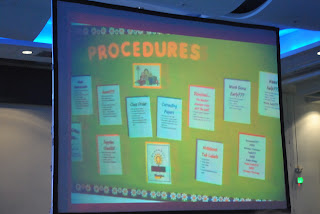A number of academic leaders from the Grade School and High School Departments joined throngs of other educators nationwide to listen to world-reknowned educator and speaker, Dr. Harry K. Wong, last July 28, 2012.
The delegation was led by Sr. Virginia Taguinod, SPC, the Grade School Principal and Community Superior. The members of the delegation were Sr. Ma. Gemma Moralita, SPC, the Head for Christian Formation, Sr. Marie Anne Adonacion, SPC, Directress-Principal of St. Paul School of Sta. Maria, Mr. Ernesto Guillermo, Jr., the HS Academic Chair, Mrs. Eufemia Dionson, HS Homeroom Chair, Mrs. Emmalou Pineda, the Student Welfare Committee Chair, Miss Benita Tarranza, HS Social Studies Team Leader, Miss Marita Mercado, the GS Homeroom Chair, Miss Imelda Baltazar, the GS Academic Chair, and Miss Thelma Dimaapi, the GS Clubs and Organizations Chair.
The conference was held at the SMX Convention Center at the Mall of Asia in Pasay City
Wong was joined by his wife, Rosemary, as they gave educators practical tips on becoming an effective and succesful teacher.
Dubbed as “Harry Wong in Manila
The Wongs emphasized starting every school year right and stressed on a well planned first day in school. They shared various experiences of educators in the United States and from some other countries like the Philippines
“Teachers who discipline show they are ineffective,” Harry pointed out. “The ones who are effective are those who know how to manage their classes,” he said.
“In an effective classroom, students know what to do. Effective teachers have a classroom that is structured, organized, and consistent in how a classroom is run,” he emphasized.
Rosemary, on the other hand, gave illustrative examples of effective teachers who planned well their first days in school.
Citing shared experiences of teachers across the US
She, likewise, cited the use of scripts so that no single detail would be missed out as normally the first days of school would cause jitters to some teachers.
In well planned off classroom management approach, even when the teacher is not present physically, the students would know what to do, she declared. Rosemary mentioned the use of regular bell work posts that students can do every beginning of each period. She described bell works as academic tasks that students are asked to accomplish or do at the beginning of the class to get them engaged right away, even without the presence of the teacher yet. “The bell work could also be called welcome work,” she said.
“If bell work becomes a culture in the classroom, then students would immediately know what to do,” she enthused.
“The number one problem in the classroom is not discipline,” Harry declared. “It is the lack of procedures and routines.”
“Discipline concerns how students behave, while procedures are concerned with how things are done,” he differentiated. “Effective teachers manage their classes with procedures; ineffective teachers discipline their classes with threats,” he described.
He suggested that teachers should clearly define classroom procedures and routines.
“Procedures are used to structure how things are done in the classroom, such as entering the classroom, quieting the class, getting into and doing group work, sharpening pencils, and collecting papers,” he explained.
“Classroom procedures must be rehearsed until they become routines,” he encouraged. “A procedure is what the teacher wants the students to do and a routine is what a student winds up doing automatically after rehearsal,” he noted. He mentioned three steps to teaching classroom procedures – teach, rehearse, reinforce.
Among the recurring procedures that Harry mentioned were beginning a class, taking turns speaking, getting help, turning in homework or classwork, taking lecture notes, reading a chapter, doing a homework, or getting students’ attention.
“Research shows that effective teachers spend most of the first week teaching students to follow classroom procedures,” he revealed.
“Procedures do not have to be presented in PowerPoint,” Rosemary added. She cited that the procedures could be posted in classroom bulletin boards, on the armchairs, or even in a very creative way like rapping them in a song.
Harry pointed out that “all effective schools and classrooms have a culture of consistency, a structure and organization of how the school and the classroom are run.”
“The reason for most failures of students,” he said, “is failure to know what procedures and objectives they are responsible for.” Wong cited the study of John Hattie of the University of Auckland
“If the students know what they are aiming for, they know what they are responsible for learning,” Wong said. “Students get more done when they see where they are going and what they are doing.”
He emphasized the importance of assessment over evaluation of student achievements. “When you are sick, the doctor does not grade you,” he illustrated. “The doctor assesses your test results and provides medication or treatment to improve your health,” he said. Assessment of student achievement could be facilitated with the use of rubrics, Wong declared. “Even the students themselves can objectively assess themselves by following the rubrics,” Wong said. “Just think what would happen to student learning if the students knew what they were to learn and how they would be assessed, thus they knew they could not fail,” he challenged. “A rubric is used to assess student learning and provide instruction for student progress.”
Rosemary mentioned of “Dancing with the Stars” TV program in the US US
“Students will succeed when they know what they are to learn, how they are to learn it, how the quality of their learning will be assessed, and how they are to demonstrate what they have learned,” Wong said. “Effective schools have a culture of consistency,” he emphasized. “You are the difference in the life of a child,” he ended.
The conference was attended by more than 3,000 educators from all over the country for the morning session. The conference had two runs.
The conference was attended by more than 3,000 educators from all over the country for the morning session. The conference had two runs.















No comments:
Post a Comment